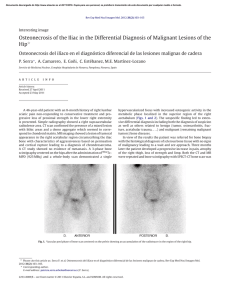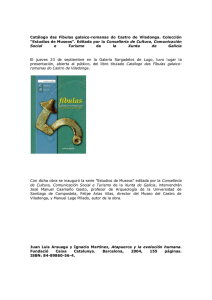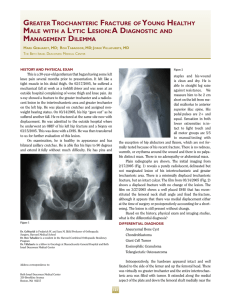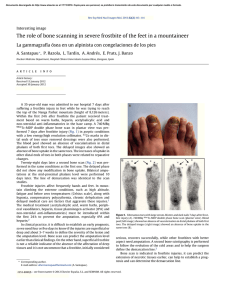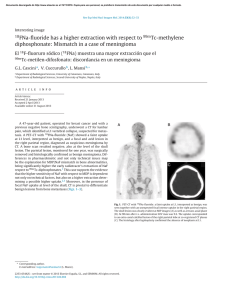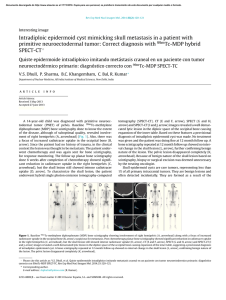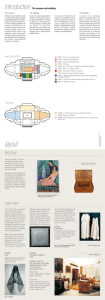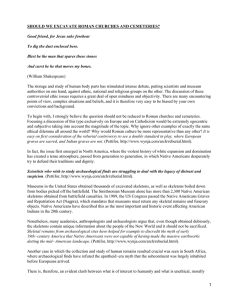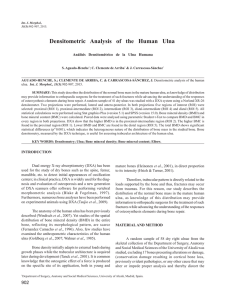Bone Tool Types and Microwear Patterns
Anuncio
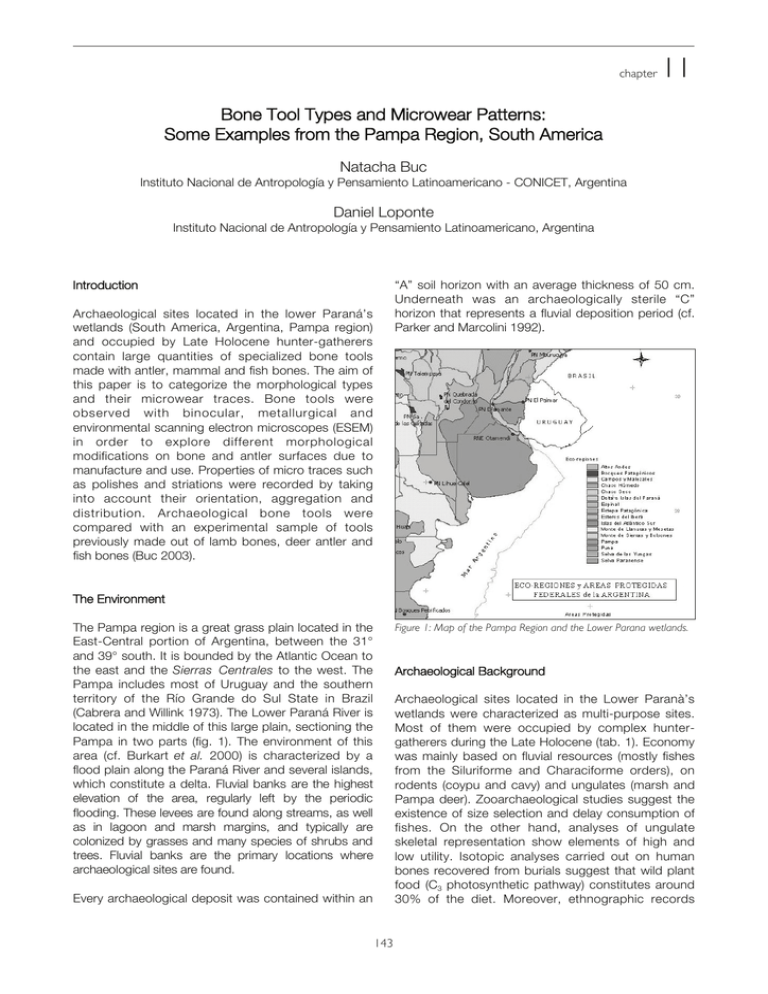
chapter 11 Bone Tool Types and Microwear Patterns: Some Examples from the Pampa Region, South America Natacha Buc Instituto Nacional de Antropología y Pensamiento Latinoamericano - CONICET, Argentina Daniel Loponte Instituto Nacional de Antropología y Pensamiento Latinoamericano, Argentina “A” soil horizon with an average thickness of 50 cm. Underneath was an archaeologically sterile “C” horizon that represents a fluvial deposition period (cf. Parker and Marcolini 1992). Introduction Archaeological sites located in the lower Paraná’s wetlands (South America, Argentina, Pampa region) and occupied by Late Holocene hunter-gatherers contain large quantities of specialized bone tools made with antler, mammal and fish bones. The aim of this paper is to categorize the morphological types and their microwear traces. Bone tools were observed with binocular, metallurgical and environmental scanning electron microscopes (ESEM) in order to explore different morphological modifications on bone and antler surfaces due to manufacture and use. Properties of micro traces such as polishes and striations were recorded by taking into account their orientation, aggregation and distribution. Archaeological bone tools were compared with an experimental sample of tools previously made out of lamb bones, deer antler and fish bones (Buc 2003). The Environment The Pampa region is a great grass plain located in the East-Central portion of Argentina, between the 31° and 39° south. It is bounded by the Atlantic Ocean to the east and the Sierras Centrales to the west. The Pampa includes most of Uruguay and the southern territory of the Río Grande do Sul State in Brazil (Cabrera and Willink 1973). The Lower Paraná River is located in the middle of this large plain, sectioning the Pampa in two parts (fig. 1). The environment of this area (cf. Burkart et al. 2000) is characterized by a flood plain along the Paraná River and several islands, which constitute a delta. Fluvial banks are the highest elevation of the area, regularly left by the periodic flooding. These levees are found along streams, as well as in lagoon and marsh margins, and typically are colonized by grasses and many species of shrubs and trees. Fluvial banks are the primary locations where archaeological sites are found. Figure 1: Map of the Pampa Region and the Lower Parana wetlands. Archaeological Background Archaeological sites located in the Lower Paranà’s wetlands were characterized as multi-purpose sites. Most of them were occupied by complex huntergatherers during the Late Holocene (tab. 1). Economy was mainly based on fluvial resources (mostly fishes from the Siluriforme and Characiforme orders), on rodents (coypu and cavy) and ungulates (marsh and Pampa deer). Zooarchaeological studies suggest the existence of size selection and delay consumption of fishes. On the other hand, analyses of ungulate skeletal representation show elements of high and low utility. Isotopic analyses carried out on human bones recovered from burials suggest that wild plant food (C3 photosynthetic pathway) constitutes around 30% of the diet. Moreover, ethnographic records Every archaeological deposit was contained within an 143 BONES AS TOOLS: CURRENT METHODS AND INTERPRETATIONS IN WORKED BONE STUDIES coefficient (Neiff 1999). Hence, environment shows high sedimentation rates, low aeolian and fluvial erosion as well as high and localized soil formation. Artifacts on the surface are rapidly captured by point out to the existence of storage, delay consumption and active territorial defense of the primary catchments areas during the XVIth century (Loponte et al. 2002). Table 1: Archaeological pampean sites with bone tool examples discussed in the text Site Las Vizcacheras Las Vizcacheras Garín Anahí Ao. Guazunambí La Bellaca sitio 1 La Bellaca sitio 2 Latitude 34° 16' 81" 34° 16' 81" 34° 22' 38" 34° 16' 95" 34° 23' 33'' 34° 23' 07" 34° 22' 79" Longitude 58° 48' 11" 58° 48' 11" 58° 42' 30" 58° 48' 47" 58° 09' 34'' 58° 40' 14" 58° 39' 53" 14C BP (conventional) 1090±40 1070±60 1060±60 1020±70 940±60 1110±70 680±80 Lab No Beta 148-237 LP-1401 LP240 Beta 147-108 Beta 147-109 LP-1288 LP-1263 Sample dated Guanaco Seed palm Marsh deer Coypu Mammal bone Coypu Mammal bone grasses, thus initiating the burial process. Therefore, bone assemblages have low weathering profiles presenting predominantly 1-2 stages (Acosta 1997, Loponte and Acosta 2002). Even though bones are mineralized to some extent by contact with salts and manganese oxides, the action of diagenetic processes was low. Not only does the C/N ratio obtained from human bones falls between 2.9 and 3.6, but bones also tend to preserve high collagen content (Acosta and Loponte 2002). Correlations between bone mineral density and %MAU for ungulate and fish bones were null (Acosta et al. 2002, Loponte and Acosta 2002). The low frequency of carnivore and rodent marks in faunal collections suggest that destruction and/or modification by these agents was not significant (Acosta 1997, 2004). Sherds and bones have no evidence of rolling. Likewise, lithic flakes have low rates of postdepositional alteration (Sacur Silvestre 2004). Root marks cover less than 5% of the surface of a great number of mammal bone specimens, and even less for fish bones. In a few cases, these root marks represent a problem to microscopic analysis because they modified or destroyed use features. Micro traces are also seldom obscured by small and circular “pittings” which could be consequence of soil acid action. However, given these general results and proxy data related with archaeological deposits, we presume that bone assemblages are not significantly modified by natural causes. Therefore, the integrity of bone tools is acceptable for microwear analysis. Regarding technological aspects, deposits have abundant domestic plain pottery with charcoal residues on the exterior surface (Perez and Cañardo 2004) and decorated sherds. Furthermore, deposits contain specialized equipment for prey capture: lithic projectile points, bola stones, bone hooks of spearthrower and different types of projectile points made in antler and bone. The diversity and abundance of bone tool assemblages characterise archaeological sites located in the Paraná’s wetlands (Caggiano 1984; Lothrop 1932; Zeballos and Pico 1878). Bone industry is not well developed in the rest of the Pampa where bone artifacts are few and have little modification (Gonzalez de Bonaveri 2003; Johnson et al. 2000; Mazanti and Valverde 2001). Lack of local lithic quarries makes the analysis of bone tools crucial; not only in the lower Paraná’s wetlands, but also in similar zones as well (Perez Jimeno 2004a, 2004b). However, the explanation proposed for the development of bone technology as determined by the absence of rocks is nowadays partially questioned. On the basis of morphological features and economic organization of local huntergatherers during the Late Holocene, the hypothesis of partial complementary function between lithic and bone materials in the area has recently been proposed (Loponte and Sacur Silvestre 2002). Current microscopic analysis on lithic natural flakes shows patterns of work on hard materials such as bone and antler (Sacur Silvestre 2004). Conversely, bone tools would have achieved activities according to their mechanical properties. Moreover, the importance of fishing in the economy and the utilization of large quantities of hide (obtained from small rodents, mainly coypu), could be an explanation for the development of specific bone tools (harpoons and awls) as related to specific resources (Loponte and Sacur Silvestre 2002). A first microscopic approach to the faunal assemblage showed that several bones without modification have intense bright similar to those recorded on archaeological tools (which may be due to postdepositional processes). However, as Lyman noted, these features are different in location and aggregation to those recorded in bone tool assemblages (Lyman 1994). This statement is useful to the analysis if formal tools like the ones examined here. However, it should be taken into account for the analysis of less formal tools that could be remaining in Taphonomy The Paraná wetlands have a very low elasticity 144 BONE TOOL TYPES AND MICROWEAR PATTERNS: SOME EXAMPLES FROM THE PAMPA REGION, SOUTH AMERICA – BUC AND LOPONTE techniques used in the experimental program (Buc 2005). A binocular microscope working at magnifications between 5X and 50X was used for initial examination of tools to provide general information about the extent and distribution of wear. For higher magnifications, incident-light metallurgical microscope with magnifications ranges of 50X, 100X and 200X was used for most of the work. To explore the patterns defined by optical techniques, we used an environmental scanning electron microscope (ESEM) at 100X-150X, rarely at higher magnifications. To describe the microscopic patterns we mostly follow the terminology defined by LeMoine (1991). In the following sections, we summarize the results of this analysis presenting the archaeological tool types and the associated patterns of use-wear. the faunal assemblage. Materials and Methods The program designed for microscopic examination of archaeological tools follows the pattern of use-wear analyses initially developed by Semenov (1964) and continued by other authors. Following methodological approaches from lithic technology (Keeley 1980; Vaughan 1985), several microwear studies were conducted to identify or test the function of archaeological bone tools. Essentially, authors with different theoretical models and particular problems base their research programs on actualistic information (taphonomical, ethnographical and/or experimental) and archaeological examination of tools at different magnifications (Bouchud 1977; Campana 1989; d´Errico and Blackwell 2003; d´Errico and Villa 1997; Greenfield 1999; Griffitts 1997; LeMoine 1991; Nami and Scheinsohn 1997; Newcomer 1974, Olsen 1979, Runnings et al. 1989; Scheinsohn 1997; Shipman 1989; Stordeur and Anderson-Gerfaud 1985). Their main conclusion is that different materials leave identifiable traces on bone and antler. Considering patterns of features (instead of individual traces) and distinguishing natural from cultural marks, function of archaeological bone tools can be assigned. Therefore, based on the patterns of marks that resulted from a previous experimental program (Buc 2005), we expect to identify the materials worked with the archaeological tools and the general activities implied. Results of Archaeological Analysis: Use-Wear of Bone and Antler Tools Awls Awls are defined by a pointed tip made on any bone splinter (Camps Fabrer 1967: 280). Nevertheless, this analysis is exclusively focused on those awls that retain either the proximal or the distal epiphysis. This kind of tool is well known in different parts of the world, including the Pampa region (Ameghino 1880; Caggiano 1984; Lothrop 1932; Mazzanti and Valverde 2001). Different authors have suggested two main uses for these artifacts: as manipulators in the making of basketry (Campana 1989; Olsen 1979) or as perforators in the working of hide (Campana 1989; LeMoine 1991). Awls under study are all made out of metapodials of adult Ozotoceros bezoarticus (Pampa deer) and juvenile Blastocerus dichotomus (marsh deer) (fig. 2). In this essay we examine a small sample of archaeological bone artifacts from sites located in Paraná’s wetlands, dated between 680 and 1100 radiocarbon years BP. Accordingly, the aim is to explore the function of bone and antler tools in this particular context. The overall assemblage is composed of 150 bone and antler formal tools, which are distributed mainly in six morphological groups analyzed here. Details of the manufacturing procedures of the bone tools can be found in Acosta (2000) and Buc (2005). Categories such as beads of canine teeth, perforated antlers, fractured artifacts and other undetermined tools are not included in the present study. Instead, this first analysis is concentrated only in those well defined morphological types. Some tool groups analyzed, such as hooks, spearthrowers or harpoons usually do not have disputed functions. Conversely, other categories have less clear functions, for example bipoints, pin-like objects, awls and smoothers. Figure 2: Archaeological awls. The manufacture of these awls implies a careful design. Striations found microscopically along their shafts suggest that they were made by grinding bone with a coarse grained stone (fig. 3 and 4). Microscopic examination of archaeological pieces went through three levels of analysis, following the 145 BONES AS TOOLS: CURRENT METHODS AND INTERPRETATIONS IN WORKED BONE STUDIES visible here. Figure 3: Archaeological awl: the tip shows manufacture features left by grinding bone with a coarse-grained stone on its lateral. Metallographic Microscope, 50x. Figure 5: Archaeological awl: the tip shows short smooth transversal striations and invasive polish. Metallographic microscope, 50x. Figure 4: Archaeological awl: the tip shows manufacture features left by grinding bone with a coarse-grained stone on its blade. SEM, 65x. Figure 6: Archaeological awl: the tip shows short and smooth transversal striations. SEM, 65x. Manufacturing features are regularly obscured by later use-wear marks, which are defined by rounded blades and tips, and short smooth striations across the shaft (fig. 5 and 6). Several authors have defined these traces as characteristic of piercing hide (Griffits 1997; LeMoine 1991). Moreover, striations are similar in orientation and aggregation to the ones recorded in experimental awls made on metatarsal lamb bones and used to pierce dry coypu hide for a duration of 45 minutes (fig. 7). Striations observed in experimental awls used 45 minutes to pierce fresh coypu hide (Buc 2003) are scarce and more widespread (fig. 8). Since both types could be indicative of different stages on a continuum (LeMoine 1991), we can only conclude that archaeological tools were used on a soft material similar to hide and that an action involving piercing movements was carried out. The exposure of osteons was recorded by LeMoine (1991) as a characteristic feature of working wet materials, but they were not Figure 7: Traces left by piercing dry coypu hide: the tip of an experimental awl shows short and smooth transversal striations, and invasive polish. Metallographic microscope, 50x. 146 BONE TOOL TYPES AND MICROWEAR PATTERNS: SOME EXAMPLES FROM THE PAMPA REGION, SOUTH AMERICA – BUC AND LOPONTE Use-wear traces appear very different from manufacture grooves. There are two main patterns of use-wear. Some tools show light, smooth, and transversally oriented striations confined to the tip, similar to the use-wear pattern of awls but less developed (fig. 10). Other pin-like tools show a different use-wear pattern also confined to the tip. In these cases, deep parallel and short striations are mainly seen on the highest points of the bone surface and rarely follow the microtopography of the bone (fig. 11 and 12). The latter pattern could be associated with a soft material but slightly more abrasive and rigid than hide, probably vegetal. In fact, experimental tools used with local gramineous plants during 45 minutes show a similar pattern. Striations, though similar to the ones recorded in hide processing, are deeper and seldom follow the microtopography of the bone (compare fig. 13 with fig. 12). Figure 8: Traces left by piercing fresh coypu hide: the tip of an experimental awl shows short and smooth transversal striations. These features are scarcer and more widespread than on figure 7. Metallographic microscope, 50x. Pin-like Tools Pin-like tools are tipped objects, as defined by Campana (1989: 51), generally made from rays of Siluriforme fishes (fig. 9). They are too fine to be defined as awls and have no eye, so cannot be included in the “needle” category (as defined by Camps-Fabrer 1967). Most of the tools under study have their articular ends broken and only their tips have been often abraded while the rest of the tool remains unmodified. Under microscopic examination, coarse striations oblique and confined to the tip can be seen. Thus, we can state that little energy and time were involved in the manufacture of these artifacts. Figure 10: Archaeological pin-like tool: the tip shows light smooth transversal striations confined to the tip. Metallographic microscope, 50x. Smoothers This category defines a peculiar tool type made from rays of siluriforme fishes (fig. 14). The original bone elements are slightly modified but show a bright and localized polish visible with the naked eye. There are no references of similar tools in other areas of Argentina, while identical tools are recorded in Brazilian sites without artifactual descriptions (Schmitz et al. 1993: fig. 41). Under optical microscopic examination, these objects show deep transversally oriented striations (fig. 15 and 16). These features are confined to an area between 2 and 3cm below the tip and decrease in number and intensity away from it. Use-wear marks erase the natural fish bone grooves that remain intact in the rest of the tool. In this last area, isolated striations sometimes appear on the high points of the bone micro-topography (fig. 17). Figure 9: Archeological pin-like tools. 147 BONES AS TOOLS: CURRENT METHODS AND INTERPRETATIONS IN WORKED BONE STUDIES As Griffitts suggested (Griffitts 1997: 243), we verified experimentally that different tempers produce different wear patterns (compare fig. 18 and 19 with fig. 10). Figure 11: Archaeological pin-like tool: the tip shows short transversally oriented striations on highest points of the bone surface. Invasive striations can be seen on the left corner of the picture. Metallographic microscope, 50x. Figure 14: Archaeological pottery smoothers. Figure 12: Archaeological pin-like tool: the tip shows short, deep, and transversally oriented striations on the blade. Metallographic microscope, 50x. Figure 15: Archeological pottery smoothers: the polished area shows deep, transversally oriented striations obscuring the natural grooves of the bone. Metallographic microscope, 50x. Bipoints Figure 13: Traces left by rubbing local gramineous plant: short, deep, and transversally oriented striations. Metallographic microscope, 50x. Bipoints or double-pointed implements (Campana 1989: 47) are narrow tools pointed on both ends with sizes ranging from 11 cm long, a thickness of approximately 0.7 cm and a maximum width of 1cm (fig. 20). These objects are completely modified, so it is usually not possible to identify the original bone from which they were made. This tool type is not common in other Argentinean contexts. However, a very similar object was described as a piercing tool by Most patterns are similar to the one recorded in experimental tools used to smooth pottery for a period of one hour (Buc 2003) and are comparable to those described by Griffitts (1997). Although archaeological tools show general patterns very similar to the experimental assemblage, striations are not identical because the first ones are narrower. This difference may be related with temper type and size. 148 BONE TOOL TYPES AND MICROWEAR PATTERNS: SOME EXAMPLES FROM THE PAMPA REGION, SOUTH AMERICA – BUC AND LOPONTE (fig. 21). In some cases, extremities show different use-wear patterns. For instance, one tool (LB2 52) has slightly smooth manufacturing features and transverse marks on its proximal end (fig. 22 and 23), while the distal end shows a non-invasive polish and intact manufacturing traces (fig. 24). This suggests that different actions or materials would have affected each distal end and that the midsection was not the active area of the tool. Hence, the working hypothesis is that only one of the tips was active and that the midsection and the other tip were hafted. This is supported by the fact that random striations and noninvasive polish correspond to patterns described by other authors as wood use (Griffitts 1997; LeMoine 1991) and are features similar to the ones observed at the base of the hooks of spearthrowers (see below and compare fig. 21 with fig. 33). Otherwise, it is also possible that the use of bipoints could have been more generalized and that both tips could have been used alternatively in different materials and tasks. Mazzanti and Valverde (2001: 171-172), and identical artifacts were documented in Brazilian huntergatherer sites without functional determinations (Schmitz et al 1993: fig. 41). It is the most controversial tool type regarding its precise use. While some authors defined similar artifacts as hafted points used as spears or arrow points (Campana 1989; Newcomer 1974), others believe that they represent fishhooks, fish gorges or elements of composite toggling harpoons (Campana 1989; Lyman 1991). Figure 16: Archeological pottery smoothers: the polished area shows deep, transversally oriented striations obscuring the natural grooves of the bone. SEM, 90x. Figure 18: Traces left by polishing pottery: deep, transversally oriented striations obscure the natural grooves of the bone. Metallographic microscope, 50x. Figure 17: Archeological pottery smoothers: away from the polished area the tool shows deep, transversally oriented striations on the highest points of the bone’s topography. Metallographic microscope, 50x. In this particular case, we conducted the microscopic analysis to test each of these functional hypotheses. Therefore, ends and midsections were carefully analyzed. The resulting use-wear pattern is also controversial. In their midsection, most tools show random striations or only glossy non-invasive polish Figure 19: Traces left by polishing pottery: deep, transversally oriented striations obscure the natural grooves of the bone. These features are different to figure 19 due to differences in temper size. Metallographic microscope, 50x. 149 BONES AS TOOLS: CURRENT METHODS AND INTERPRETATIONS IN WORKED BONE STUDIES (Stordeur 1980). The general form is parabolic, pointed on one end and drilled on the other end to accept a shaft (fig. 25). A thin rope would have connected both shaft and point through an opening drilled on the dorsal face. Results presented by Lindström (1994) suggest that these tools have relatively high costs of manufacture. Coarse longitudinal striations seen in some pieces across the shaft suggest that harpoons were made by grinding deer antler, a suitable material for projectile points due to its mechanical properties (Guthrie 1983). Figure 20: Archeological bipoints. Figure 23: Archeological bipoint (LB2 52), proximal end: its tip shows short transversal marks. Metallographic microscope, 100x. Figure 21: Archeological bipoint: its midsection shows glossy noninvasive polish. Metallographic microscope, 100x. Figure 24: Archeological bipoint (LB2 52), distal end: its tip shows intact manufacture features on its blade. Metallographic microscope, 100x. Figure 22: Archeological bipoint (LB2 52), proximal end: its tip shows slightly smooth manufacture features on its blade. Metallographic microscope, 100x. Harpoons Harpoons are well defined ethnographically and archaeologically, so their use is not often discussed. Archaeological harpoons recovered in the lower Paranà wetlands are quite similar to the modern ones still in use among aboriginal populations in the Chaco area (Caggiano 1984). These tools resemble morphologically those defined by Stordeur as type IA for Paleoinuit inhabitants of the Igloulik region Figure 25: Archaeological harpoons. 150 BONE TOOL TYPES AND MICROWEAR PATTERNS: SOME EXAMPLES FROM THE PAMPA REGION, SOUTH AMERICA – BUC AND LOPONTE 1997; LeMoine 1991), but they are not exactly the same. Microwear features are also quite analogous to the microwear observed on the supposed hafted areas of the bipoints (see fig. 22). Such tools were examined microscopically in order to support the traditional hypothesis of use as harpoons. Although we supposed that soft tissue lubricated by water can hardly leave readily identifiable traces (LeMoine 1991), we presumed that the impact against the bony structure of fishes might modify the antler in some way. Although tool manufacture features are obscured on almost every archaeological harpoon, the micro traces found on the tips are different from one tool to the other. For example, while some tips have short transversal marks, probably due to mechanical stress (fig. 26, compare these marks with the ones recorded on the ends of bipoints on fig. 23), others have a different pattern (fig. 27). Tools do not show invasive polish under metallurgical microscope, while tips and blades appear completely rounded under ESEM (fig. 28). The results of the observations show highly variable patterns, so the analyzed samples (archaeological and experimental) must be increased. Transversal light striations were recognized in the outer opening of the pieces analyzed (fig. 29). These features are similar to the ones associated with rubbing wet hide (fig. 30) and plants (fig. 31). However, the interpretation is provisory because we did not perform an experimentation to identify these features in particular. Whichever the material that has rubbed the surface, it would have been in contact with water and, as lubrication altered the formation of features (cf. Le Moine 1991), it is not accurate to make analogies without more comparative samples. Nevertheless, these features may be the product of the thin cord made with hide or plant fibers which was used to link both parts of the harpoons. Therefore, these results support the traditional hypothesis of use. Figure 26: Archaeological harpoon: its tip shows short, transversal marks. Metallographic microscope, 100x. Figure 27: Archaeological harpoon: this tool show a different pattern to the one recorded in figure 27. Metallographic microscope, 100x. Hook of Spearthrowers Spear Points Spearthrowers (atlatl) made from wood are well defined in the ethnographic literature. Archaeologically, they are usually represented by their hooks made from bone, antler or ivory (Catellain 1997). The hooks founded in our study area are made from deer astragalae (fig. 32) and their manufacture requires a significant amount of time and energy. These artifacts are made with the compact osseous tissue of big mammal bones (probably marsh deer) (fig. 34). We have recovered only two specimens, one of them being quite similar to the one illustrated by Lothrop (1932: 179, fig. 70) and recovered from the Sarandí site. Their thickness (2.5 mm) makes them too fragile to be projectile points according to the values presented by Guthrie (1983). Microwear analysis on both points showed only coarse striations resulting from manufacture. The absence of use micro-wear traces and the intact preservation of the manufacture features suggest a low rate of surface bone modification, that pieces were not used, or both. However, more artifacts like these are needed to support any hypothesis about their precise function. As in the previous case, the use-wear analysis was designed to support traditional hypotheses about their use. Thus, the main areas explored were the base, and the concave face of the hook, presumably in contact with the projectile shaft. Both parts of the composite tools would have been made of wood. The microscopic analysis shows non-invasive, glossy polish covering the highest points in both areas (fig. 33). These features are similar to those described by other authors as resulting from work on wood (Griffitts 151 BONES AS TOOLS: CURRENT METHODS AND INTERPRETATIONS IN WORKED BONE STUDIES manufacture, respectively). Likewise, the large quantities of awls in the archaeological record could be related with the high importance of coypu (a source of small skins) in the economy as well (Loponte and Acosta 2002). Moreover, current information suggests a high correlation between tool type and osseous element used as raw material, pointing out a selection of bone materials due to regional prey availability and mechanical properties of the elements. Thus, tool design must be understood as constrained by these technological choices and technological costs (manufacture and procurement costs, cf. Bamforh and Bleed 1997) should be considered in the light of its efficiency. Figure 28: Archaeological harpoon: its blades and tip appear smoothed under SEM, 65x. Figure 30: Traces left by rubbing wet coypu hide. Metallographic microscope, 100x. Figure 29: Archaeological harpoon: the outer opening of the piece shows transversal, light striations. Metallographic microscope, 100x. Discussion The results of the microwear analysis partially support previous hypotheses about the function of bone tools based on morphological traits (Loponte and Sacur Silvestre 2002). Microwear analysis performed on lithic tools shows microwear resulting from cutting activities, principally on hard materials such as bone and antler (Sacur Silvestre 2004). Conversely, results of microwear analysis on bone tools suggest that they are linked to activities involving soft materials in contact with the pointed parts of the tools instead of their edges. Bone points and awls would have replaced lithic projectile points and drills, but harpoons, pin-like tools, pottery smoothers and spearthrowers were not made out of bone material as a response to the regional scarcity of lithic resources. Harpoons and pottery smoothers are closely related with the economic structure (fishing and pottery Figure 31: Traces left by rubbing local gramineus. Metallographic microscope, 100x. Guthrie has stated that deer antler projectile points are optimal because of their resistance (Guthrie 1983) and this is consistent with the physical structure since harpoons are made of antler. Similarly, astragalae used to make the hooks of spearthrowers are tarsal bones structurally similar to carpals, which are suggested by Currey (1984) as bones mechanically designed to resist static loads. Regarding awls, deer metapodials are equivalent to guanaco metapodials, which are good materials for actions involving high impact strength (Scheinsohn y Ferreti 1995), similar to 152 BONE TOOL TYPES AND MICROWEAR PATTERNS: SOME EXAMPLES FROM THE PAMPA REGION, SOUTH AMERICA – BUC AND LOPONTE show different use-wear patterns. Some could be associated with work on plant material, while others show a use-wear pattern resulting from hide working. The latter case is similar to the one presented by LeMoine (1991) in her analysis of awls and needles from Eskimo assemblages. Taking into account their fragile tip, it is more likely that their work on hide consists in widening holes or passing a cord through holes previously made with awls (Bouchud 1977). In addition, due to their slight modification and the abundance of fish rays as raw materials, these tools would have been used in different tasks, the previous features being obscured by the last ones. In sum, morphological groups and microwear patterns suggest tool specialization. Even though the use-wear patterns could not all be identified with a specific worked material, it is clear that they are internally homogeneous within a particular tool type. those involved in hide piercing activities. Bipoints are made from compact osseous tissue of large mammal bones. Their thickness and biconvex profile make them adequate to produce compact and resistant spears. Consequently, despite their different manufacture costs, all these tools can be defined in terms of “curated technology” (Binford 1979). Conversely, artifacts made out of fish rays, an abundant resource in the area, show features indicative of an “expeditive technology”. Not only are pottery smoothers and pin-like objects slightly manufactured, but it also may be that the latter do not show recognizable use-wear patterns because they were multipurpose expedient tools. Figure 32: Archaeological hooks of spearthrower. Figure 33: Archaeological hook of spearthrower: its concave face shows non-invasive, glossy polish covering the highest points. Metallographic microscope, 100x. Figure 34: Archaeological projectile points. Conclusion Finally, awls, pottery smoothers, harpoons and hooks of spearthrowers show distinct use-wear features that can be related, with more or less accuracy, to their specific inferred function. Although the precise function of bipoints could not be assessed, the hypothesis suggesting they may be spear points is noteworthy considering the scarcity of lithic raw materials in the area. Results presented by Guthrie regarding bone point thickness support this idea (Guthrie 1983). The thickness of the bipoints under study is always less than 7 mm, while Guthrie stated that optimal thickness to ensure penetration and durability is approximately 1 cm. The results regarding pin-like objects are also controversial because they The archaeological record in the lower Paraná wetlands occupied by late Holocene hunter-gatherers has a significant bone tool specialization. Moreover, this specialization is closely related to economic organization. Microscopic analysis shows a correlation between bone micro-wear and inferred function in several tool types, specifically in curated or formal artifacts. It is remarkable that most of them belong to a tool-kit used to obtain prey (fish and ungulates). Actualistic and taphonomic research programs are 153 BONES AS TOOLS: CURRENT METHODS AND INTERPRETATIONS IN WORKED BONE STUDIES References Cited necessary for various reasons. First of all, different authors use terms based on visual appearance to describe features (González-Urquijo and IbáñesEstévez 2003) so clear terminology and good documentation are crucial to unify descriptions. Secondly, actualistic information is necessary to deal with the particular archaeological record under study. Taphonomic aspects should be analyzed carefully to recognize and separate natural from cultural marks and post-depositional bone modifications. Acosta, A. 1997 Estados de conservación y problemas de contaminación de las estructuras arqueofaunísticas en el extremo nororiental de la Pcia. de Buenos Aires. In A r q u e o l o g í a Pampeana en la década de los ´90, ed. M. Berón and G. Politis, 187-199. San Rafael: Museo de Historia Natural de San Rafael – INCUAPA. 2000 Huellas de corte relacionadas con la manufactura de artifactos óseos en el nordeste de la provincia de Buenos Aires. Relaciones de la Sociedad Argentina de Antropología; No 25: 159-178. 2005 Zooarqueología de cazadores-recolectores del extremo nororiental de la provincia de Buenos Aires (humedal del río Paraná inferior) (Región Pampeana, Argentina). Ph.D. Dissertation. Buenos Aires: Facultad de Ciencias Naturales y Museo, Universidad Nacional de La Plata. Careful examination required for both experimental and archaeological tools imply the use of different microscopes and magnifications. General features and their extent are visible at low magnifications using a binocular microscope. Manufacturing techniques could be seen using a binocular microscope, but it is more difficult to observe details of use-wear. A metallographic microscope is more useful since it exposes polished fields as bright areas and polarization makes clear the contact between microsurfaces. However, a disadvantage is the very limited depth of field, especially when taking microphotographs. This problem can be overcome by the use of the ESEM, which greatly improves the quality of the image and the depth of field, making it easier to interpret micro-wear (see LeMoine 1991, and Runnings et al. 1989, among others). Nonetheless, many differences exist between metallographic and scanning electron microscopes. Under the incidental light of a metallographic microscope, the striations are clearly visible, but they are not as clear under an SEM where the position of the tool is less controlled in relation to the electron haze. Moreover, under a metallographic microscope the polished areas appear bright while under a SEM they look dull. Certainly, even though these differences must be carefully explored to refine the microscopic techniques, complementary use of different microscopes and magnifications allow a better understanding of micro-wear patterns. Acosta, A., D. Loponte and J. Musali. In press A Taphonomic Approach to the Icthyoarchaeological Assemblage of La Bellaca site 2, Wetland of the Lower Paraná River, Pampean Region (Argentina). In Taphonomy and Archaeozoology in Argentina, ed. M. Gutierrez et al. Bar International Series. Oxford: British Archaeological Reports. Ameghino, F. 1947 (La antigüedad del Hombre en el Plata (2 vol.). Buenos Aires: Intermundo. [Originally published 1880] Bamforth, D. and P. Bleed. 1997 Technology, Flaked Stone Technology and Risk. In Rediscovering Darwin: Evolutionary Theory and Archaeological Explanation, ed. M. Barton and A. Clark, 109-139. Archaeological Papers of the American Anthropological Association No 7. Arlington (MA): American Anthropological Association. Binford, L. R. 1979 Organization and Formation Process: Looking at Curated Technologies. Journal of Anthropological Research; vol. 35, No 3: 255273. Acknowledgments The interactions with several colleagues are greatly appreciated. In particular, thanks are due to Alejandro Acosta, Romina Sacur Silvestre and Vivian Scheinsohn. We are grateful to Genevieve LeMoine and Janet Griffits for advice and bibliography. The experimental tools were made with the collaboration of Lorena Cañardo, Maricel Perez, and David Pau. Microwear analysis was carried out at the CITEFA (Instituto de Investigaciones científicas y técnicas de las Fuerzas Armadas Argentinas) with the assistance of Alejandro Reynoso. Interpretations and errors, however, are the authors’ sole responsibility. Bleed, P. 1986 The Optimal Design of Hunting Weapons: Maintainability or Reliability. American Antiquity; vol. 51, No 4: 737-748. Bouchud, J. 1977 Les aiguilles en os. Étude comparée des traces laisées par la fabrication et l´usage sur le matériel préhistorique et les objets expérimentaux. In Deuxieme Colloque International sur l´industrie de l´os dans la Préhistoire, Méthodologie appliquée a l´industrie de l´os préhistorique, ed. 154 BONE TOOL TYPES AND MICROWEAR PATTERNS: SOME EXAMPLES FROM THE PAMPA REGION, SOUTH AMERICA – BUC AND LOPONTE Pampeana). Ph.D. Dissertation. Buenos Aires: Facultad de Filosofía y Letras, Universidad de Buenos Aires. H. Camps-Fabrer, 257-267. Paris: CNRS. Buc, N. 2003 Análisis de microdesgaste en instrumentos óseos del humedal del Paraná inferior. Paper presented at the VI Jornadas de Jóvenes Investigadores en Ciencias Antropológicas, Buenos Aires. González-Urquijo, J. E. and J. J. Ibáñez-Estévez. 2003 The Quantification of Use-Wear Polish Using Image Analysis: First results. Journal of Archaeological Science; vol. 30, No 4: 481-489. Greenfield, H. 1999 The Origins of Metallurgy: Distinguishing Stone from Metal Cut-Marks on Bones from Archaeological Sites. Journal of Archaeological Science; vol. 26, No 7: 797-808. Burkart, R., N. Bárbaro, R. Sánchez and D. Gómez. 2000 Eco-regiones de la Argentina. Buenos Aires: Administración de Parques Nacionales, Presidencia de la Nación. Cabrera, A and A. Willink. 1973 Biogeografía de América Latina. Serie Biología, Monografía 13. Washington: Organización de Estados Americanos (AEO). Griffits, J. L. 1997 Replication and Analysis of Bone Tools. In Proceedings of the 1993 Bone Modification Conference, Hot Springs, South Dakota, ed. L. A. Hannus, L. Rossum and R. P. Winhan, 236246. Occasional Publication No 1. Sioux Falls (SD): Archaeology Laboratory, Agustana College. Caggiano, M. A. 1984 Prehistoria del NE. Argentino. Sus vinculaciones con la República oriental del Uruguay y Sur de Brasil. Pesquisas (Série Antropología); No 38: 1109. Guthrie, D. 1983 Osseous Projectile Point: Biological Considerations Affecting Raw Material Selection and Design Among Paleolithic and Paleoindian Peoples. In Animals and Archaeology: 1. Hunters and their Prey, ed. J. Clutton-Brock and C. Grigson, 274-29. BAR International Series No 163. Oxford: British Archaeological Reports. Campana, D. 1989 Natufian and Protoneolithic Bone Tools. The Manufacture and Use of Bone Implements in the Zagros and the Levant. BAR International Series No 494. Oxford: British Archaeological Reports. Camps-Fabrer, H. 1967 Typologie de l’industrie osseuse en Afrique du Nord et au Sahara. In Congrès panafricain de préhistorie, Dakar 1967, actes de la 6e session, ed. H.-J. Hugot, 279-283. Chambéry: Imprimeries réunies. Johnson, E., G. Politis and M. Gutierrez. 2000 Early Holocene Bone Technology at the La Olla 1 Site, Atlantic Coast of the Argentine Pampas. Journal of Archaeological Science; vol. 27, No 6: 463-477. Cattellain, P. 1997 Hunting during the Upper Paleolithic: Bow, Spearthrower or Both? In Projectile Technology, ed. H. Knetcht, 213-240. New York: Plenum Press. Keeley, L. 1980 Experimental Determination of Stone Tool Use. Chicago: University of Chicago Press. LeMoine, G. 1991 Experimental Analysis of the Manufacture and Use of Bone and Antler Tools among the Mackenzie Inuit. Ph.D. Dissertation. Calgary: Department of Archaeology, University of Calgary. Currey, J. 1984 What Should Bones be Designed to Do? Calcified Tissue International; vol. 36, supplement 2: 7-10. D´Errico, F. and L. Blackwell. 2003 Possible Evidence of Bone Tools Sharping by Swarktrans Early Hominids. Journal of Archaeological Science; vol. 30, No 12: 15591576. Lindström, S. 1994 Great Basin Fisherfolk: Optimal Diet Breath Modeling the Truckee River Aboriginal Subsistence Fishery. In Prehistoric HunterGatherer Fishing Strategies, ed. M Plew, 114174. Boise (ID): Boise State University. D´Errico, F. and P. Villa. 1997 Holes and Grooves: The Contribution of Microscopy and Taphonomy to the Problem of Art Origins. Journal of Human Evolution; vol. 33, No 1: 1-31. Loponte, D, A. Acosta and J. Musali. 2006 Complexity among Hunter-Gatherers from the Pampean Region, Argentina. In Beyond Affluent Foragers, ed. C. Grier, J. Kim, and J. Uchiyama, 106-125. Oxford: Oxbow Books. Gonzalez de Bonaveri, M. I. 2003 Los cazadores recolectores pescadores de la cuenca inferior del Río Salado (Región Loponte, D. and A. Acosta. 2004 Late Holocene Hunter-Gatherers from the 155 BONES AS TOOLS: CURRENT METHODS AND INTERPRETATIONS IN WORKED BONE STUDIES Perez Jimeno, L. 2004 Análisis comparativos de dos conjuntos de artifactos óseos procedentes de la llanura aluvial del Paraná y la pampa bonaerense. In Aproximaciones contemporáneas a la arqueología pampeana: Perspectivas teóricas, methodológicas, analíticas y casos de estudio, ed. G. Martínez, M. Gutierrez, R. Curtoni, M. Berón and P. Madrid, 319-333. Tandil: Universidad Nacional del Centro de la Provincia de Buenos Aires. in press Explotación de materia prima ósea y la optimización en la utilización de los recursos. In Actas XIV Congreso Nacional de Arqueología Argentina. Rosario. Pampean Wetlands, Argentina. In Zooarchaeology of South America, ed. G. L. Mengoni Goñalons, 39-57. BAR International Series. Oxford: British Archaeological Reports. Loponte, D. and R. Sacur Silvestre. In press Lejos de las canteras: La explotación de recursos líticos en el Sector Centro-Oriental de la Región Pampeana. Relaciones. Lothrop, S. 1932 Indians of the Paraná Delta River. Annals of the New York Academy of Science; vol. 33: 77-232. Lyman, L. 1991 Archaeology of Umpqua/Eden. Prehistory of the Oregon Coast (The Effects of Inquiry). New York: Academic Press. Perez, M. and L. Cañardo. 2004 Producción y uso de cerámica en el norte de la provincia de Buenos Aires. In Aproximaciones contemporáneas a la arqueología pampeana: Perspectivas teóricas, methodológicas, analíticas y casos de estudio, ed. G. Martínez, M. Gutierrez, R. Curtoni, M. Berón and P. Madrid, 335-349. Tandil: Universidad Nacional del Centro de la Provincia de Buenos Aires. Lyman, L. 1994 Vertebrate Taphonomy. Cambridge: Cambridge University Press. Mazzanti, D. and F. Valverde. 2001 Artefactos sobre hueso, asta y valva. In Cazadores recolectores de las Sierras de Tandilia Oriental 1: Geología, Paleontología y Zooarqueología. Laboratorio de Arqueología, ed. D. L. Mazzanti and C. A. Quintana, 167-181. Publicación Especial 1. Mar del Plata: Laboratorio de Arqueología, Universidad Nacional de Mar del Plata. Runnings, A., C. Gustafson and D. Bentley. 1989 Use-Wear on Bone Tools: A Technique for Study Under the Scanning Electron Microscope. In Bone Modification, ed. R. Bonnischen and M. Sorg, 259-266. Orono (ME): Centre for the Study of the First Americans, Institute for the Quaternary Studies, University of Maine. Nami, H. and V. G. Scheinsohn. 1997 Use-Wear Patterns on Bone Experimental Flakers: A Preliminary Report. In Proceedings of the 1993 Bone Modification Conference, Hot Springs, South Dakota, ed. L. A. Hannus, L. Rossum and R. P. Winhan, 256-264. Occasional Publication No 1. Sioux Falls (SD): Archaeology Laboratory, Agustana College. Sacur Silvestre, R. 2004 Análisis de rastros de uso en lascas de filo natural del sitio arqueológico Anahí. In Aproximaciones contemporáneas a la arqueología pampeana: Perspectivas teóricas, methodológicas, analíticas y casos de estudio, ed. G. Martínez, M. Gutierrez, R. Curtoni, M. Berón and P. Madrid, 183-203. Tandil: Universidad Nacional del Centro de la Provincia de Buenos Aires. Neiff J. J. 1999 El régimen de pulsos en ríos y grandes humedales de Sudamérica. In Tópicos sobre humedales subtropicales y templados de Sudamérica, ed. A. Malvárez, 97-146. Buenos Aires: Universidad de Buenos Aires. Scheinsohn, V. G and J. L. Ferreti 1995 Mechanical Properties of Bone Materials as Related to Design and Function of Prehistoric Tools from Tierra del Fuego (Argentina). Journal of Archaeological Science; vol. 22, No 6: 711717. Newcomer, M. 1974 Study and Replication of Bone Tools from Ksar Akil (Lebanon). World Archaeology; vol. 6, No 2: 138-153. Olsen, S. 1979 A study of Bone Artifacts fom Grasshopper Pueblo, AZ. The Kiva; vol. 44, No 4: 341-371. Scheinsohn, V. G. 1997 Use-Wear Patterns on Bark Removers. In Proceedings of the 1993 Bone Modification Conference, Hot Springs, South Dakota, ed. L. A. Hannus, L. Rossum and R. P. Winhan, 265276. Occasional Publication No 1. Sioux Falls (SD): Archaeology Laboratory, Agustana College. Parker, G. and S. Marcolini. 1992 Geomorfología del delta del Paraná y su extensión al Río de la Plata. Revista de la Asociación Geológica Argentina; vol. 47, No 2: 243-249. Schmitz, P. I., I. Verardi, A. L. Jacobus and M. Barberi Ribeiro. 1993 Escavacoes arqueológicas do Pe. Jao Alfredo Rohr, S. J. Pesquisas. Antropología No 44. Rio 156 BONE TOOL TYPES AND MICROWEAR PATTERNS: SOME EXAMPLES FROM THE PAMPA REGION, SOUTH AMERICA – BUC AND LOPONTE Recherche sur les grandes civilisations. Cahier N°2, Préhitoire: enquetes et méthodes. Paris: Editions ADPF. Grande do Sul (Brasil): Instituto Anchietano de Pesquisas. Semenov, S. 1964 Tecnología prehistórica. Madrid: Universidad. [Originally published 1964] Stordeur, D. and P. Anderson-Gerfaud. 1985 Les omoplates enconchées néolithiques de Ganj Dareh (Iran): Étude morphologique et fonctionelle. Cahiers de l´Euphrate; No 4: 199313. Akal Shipman, P. 1989 Altered Bones from Olduvai Gorge, Tanzania: Techniques, Problems, and Implications of Their Recognition. Bone Modification, ed. R . Bonnischen and M. Sorg, 317-334. Orono: Centre for the Study of the First Americans, Institute for the Quaternary Studies, University of Maine. Vaughan, P. C. 1985 Use Wear Analysis of Flaked Stone Tools. Tucson: University of Arizona Press. Zeballos, E. and P. Pico. 1878 Informe sobre el túmulo prehistórico del Túmulo de Campana. Anales de la Sociedad Científica Argentina; No 6: 244-260. Stordeur, D. 1980 Harpons Paléo-Esquimaux de la région d´Igloulik. . 157
